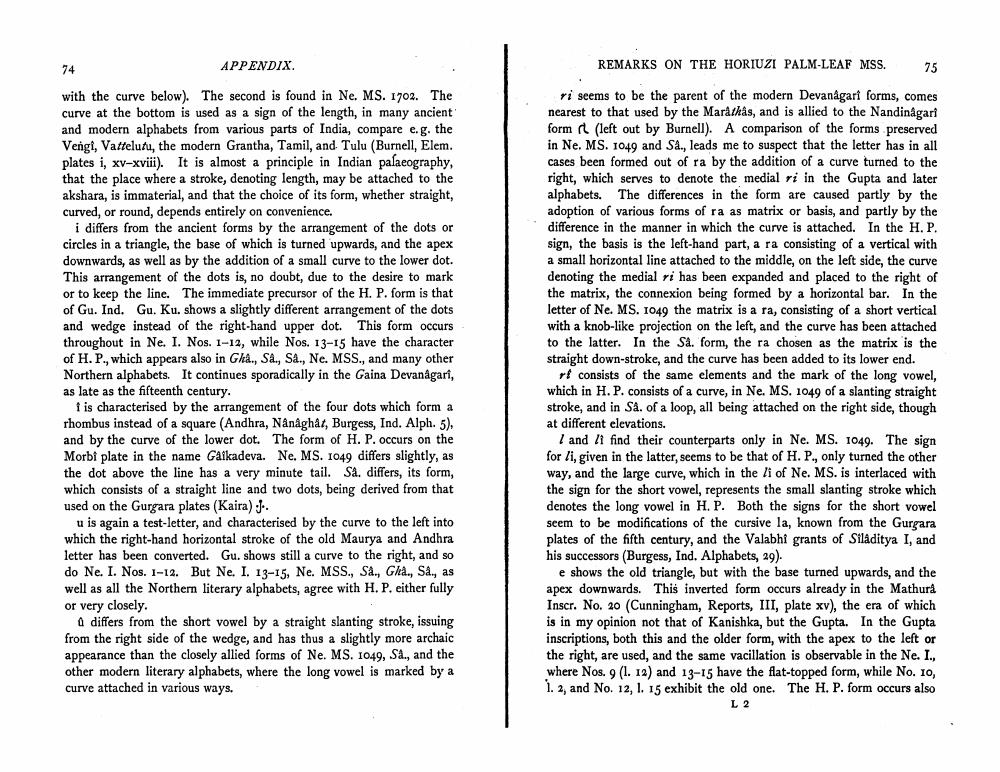________________
APPENDIX.
REMARKS ON THE HORIUZI PALM-LEAF MSS.
75
with the curve below). The second is found in Ne. MS. 1702. The curve at the bottom is used as a sign of the length, in many ancient and modern alphabets from various parts of India, compare c.g. the Vengi, Vattelutu, the modern Grantha, Tamil, and Tulu (Burnell, Elem. plates i, xv-xviii). It is almost a principle in Indian palaeography, that the place where a stroke, denoting length, may be attached to the akshara, is immaterial, and that the choice of its form, whether straight, curved, or round, depends entirely on convenience.
i differs from the ancient forms by the arrangement of the dots or circles in a triangle, the base of which is turned upwards, and the apex downwards, as well as by the addition of a small curve to the lower dot. This arrangement of the dots is, no doubt, due to the desire to mark or to keep the line. The immediate precursor of the H. P. form is that of Gu. Ind. Gu. Ku. shows a slightly different arrangement of the dots and wedge instead of the right-hand upper dot. This form occurs throughout in Ne. I. Nos. 1-12, while Nos. 13-15 have the character of H.P., which appears also in Gla., Sa., Sa., Ne. MSS., and many other Northern alphabets. It continues sporadically in the Gaina Devanagari, as late as the fifteenth century.
i is characterised by the arrangement of the four dots which form a rhombus instead of a square (Andhra, Nânåghat, Burgess, Ind. Alph. 5), and by the curve of the lower dot. The form of H. P. occurs on the Morbi plate in the name Gaikadeva. Ne. MS. 1049 differs slightly, as the dot above the line has a very minute tail. Sa. differs, its form, which consists of a straight line and two dots, being derived from that used on the Gurgara plates (Kaira):..
u is again a test-letter, and characterised by the curve to the left into which the right-hand horizontal stroke of the old Maurya and Andhra letter has been converted. Gu. shows still a curve to the right, and so do Ne. I. Nos. 1-12. But Ne. I. 13-15, Ne. MSS., Sa., Gha., Sa., as well as all the Northern literary alphabets, agree with H. P. either fully or very closely.
A differs from the short vowel by a straight slanting stroke, issuing from the right side of the wedge, and has thus a slightly more archaic appearance than the closely allied forms of Ne. MS. 1049, Sa., and the other modern literary alphabets, where the long vowel is marked by a curve attached in various ways.
ri seems to be the parent of the modern Devanagari forms, comes nearest to that used by the Marathas, and is allied to the Nandinagari form (left out by Burnell). A comparison of the forms preserved in Ne. MS. 1049 and Sa., leads me to suspect that the letter has in all cases been formed out of ra by the addition of a curve turned to the right, which serves to denote the medial ri in the Gupta and later alphabets. The differences in the form are caused partly by the adoption of various forms of ra as matrix or basis, and partly by the difference in the manner in which the curve is attached. In the H.P. sign, the basis is the left-hand part, a ra consisting of a vertical with a small horizontal line attached to the middle, on the left side, the curve denoting the medial ri has been expanded and placed to the right of the matrix, the connexion being formed by a horizontal bar. In the letter of Ne. MS. 1049 the matrix is a ra, consisting of a short vertical with a knob-like projection on the left, and the curve has been attached to the latter. In the Sa. form, the ra chosen as the matrix is the straight down-stroke, and the curve has been added to its lower end.
rl consists of the same elements and the mark of the long vowel, which in H. P. consists of a curve, in Ne. MS. 1049 of a slanting straight stroke, and in Sa. of a loop, all being attached on the right side, though at different elevations.
I and I find their counterparts only in Ne. MS. 1049. The sign for li, given in the latter, seems to be that of H.P., only turned the other way, and the large curve, which in the li of Ne. MS. is interlaced with the sign for the short vowel, represents the small slanting stroke which denotes the long vowel in H. P. Both the signs for the short vowel seem to be modifications of the cursive la, known from the Gurgara plates of the fifth century, and the Valabhi grants of Siladitya I, and his successors (Burgess, Ind. Alphabets, 29).
e shows the old triangle, but with the base turned upwards, and the apex downwards. This inverted form occurs already in the Mathura Inscr. No. 20 (Cunningham, Reports, III, plate xv), the era of which is in my opinion not that of Kanishka, but the Gupta. In the Gupta inscriptions, both this and the older form, with the apex to the left or the right, are used, and the same vacillation is observable in the Ne. I., where Nos. 9 (1. 12) and 13-15 have the flat-topped form, while No. 10, 1. 2, and No. 12, 1. 15 exhibit the old one. The H. P. form occurs also
L2




